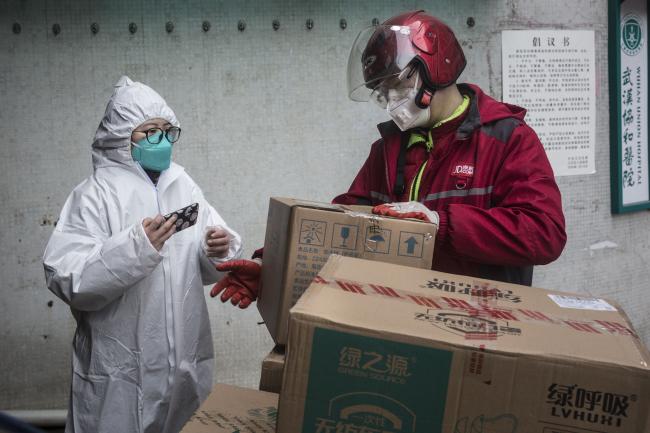(Bloomberg) -- China is expected to unveil efforts to cushion the economic blow from coronavirus, with the central bank set to keep liquidity ample and the government likely to step up spending.
Authorities will need to break their fiscal rule of a 3% deficit relative to GDP to “slow the downward spiral of economic activities,” according to Li-Gang Liu at Citigroup Inc (NYSE:C). Measures such as cutting interest rates and the proportion of deposits banks must set aside as reserves are possible, said Larry Hu, head of China economics at Macquarie Securities Ltd. in Hong Kong.
As the death toll rises and authorities lock down cities, the blow to spending and production is becoming clearer, with policy moves unlikely to avoid at least a short-term wallop. Starbucks (NASDAQ:SBUX) and Uniqlo are among the retail outlets closing down across the country, and manufacturers including Toyota Motor Corp. have halted production at least for a time.
“Beijing is unlikely to sit on its hands,” said Hu. “But liquidity-easing measures could only do so much to boost growth.”
U.S. and European equity futures slumped and Asian stocks tumbled to a seven-week low amid mounting concerns over the virus. Sovereign bonds rallied.
Growth Hit
The economic hit to China could exceed that seen during the SARS outbreak of 2003, according to Nomura Holdings Inc. Gross domestic product growth could “materially drop” this quarter from the 6% pace at the end of 2019, maybe even more than the 2 percentage point deceleration seen in the second quarter of 2003, Nomura economists led by Lu Ting wrote in a report to clients.
Policy makers will provide liquidity and credit support, especially to business owners severely affected, they said.
“RRR cuts, rate cuts, various lending facilities and open market operations all are possible options,” the Nomura economists wrote. “However, it seems unlikely that these measures would turn the economy around, as the virus outbreak may further weaken domestic demand and thus render the upcoming policy easing less effective.”
The outbreak and its aftermath will drag first-quarter GDP growth 0.9 percentage point lower to 5% as industrial production and exports decline, according to Raymond Yeung, chief China economist at Australia & New Zealand Banking Group Ltd. in Hong Kong. The loss of an extra 3.5 working days in the quarter will dent industrial production and exports while the plunge in tourism will trim the services sector’s growth, he noted.
BNP Paribas (PA:BNPP) economists Ryutaro Kono and Azusa Kato see the first-quarter growth rate falling below 5%.
JPMorgan Chase (NYSE:JPM) & Co. economists led by Zhu Haibin revised their growth forecast for 2020 to factor in the “large negative shock” in the first quarter, mainly to retail sales. They lowered the year-on-year prediction for the first quarter to 5.6% from a previous estimate of 6% and the 2020 forecast to 5.8% from 5.93% earlier.
Like most economists, the JPMorgan (NYSE:JPM) team noted that much depends on China’s ability to contain the spread of the disease.
“A more benign scenario is that the virus outbreak will successfully be contained in the next few weeks after the ‘Big Bang’ control measures,” Zhu wrote. “A more bearish scenario is that the virus outbreak will continue into 2Q, and suspension on activity will be extended and the demand shock will interact with a supply shock, adding further downward pressure.”
Serena Zhou, an economist at Mizuho Securities Asia Ltd in Hong Kong, also sees two scenarios. In the optimistic case, a “catch-up" effect in the second and third quarters allows full year GDP growth of 5.9%; in the conservative case, full-year GDP may be at least 0.3 percentage point lower than that.
Global Spillover
The global economy is likely to feel the effects, too. Federal Reserve Chairman Jerome Powell said the outbreak will likely hit the Chinese economy and could spread wider, but it was too early to judge what impact it would have on the U.S.
“We are very carefully monitoring the situation,” Powell said at a press conference Wednesday in Washington after the U.S. central bank held its benchmark interest rate steady.
Virus Poses New Threat to Economy’s Fragile Stabilization
Macquarie’s Hu said Beijing’s priority is on containment, and the earliest time for any major policy change is at April’s meeting of the Communist Party’s Politburo, by when damage to the economy can been assessed.
Liu at Citigroup (NYSE:C) said “micro-level fiscal-policy implementation will be more important to provide free medical care to affected patients, tax and interest-rate payment subsidies to firms,” especially small and medium-sized ones.
Liu also expects targeted cuts in the reserve requirement ratio for banks headquartered in Hubei and other heavily affected regions, and a one-off policy rate cut in the first quarter of at least 15 basis points.
Some of China’s largest banks have already said they will reduce interest rates for firms affected by the novel coronavirus. The People’s Bank of China said Tuesday it will conduct operations “to provide abundant liquidity in a timely manner to maintain reasonable and sufficient liquidity in the banking system.”
(Updates with markets and adds ANZ, Mizuho, BNP forecasts)
